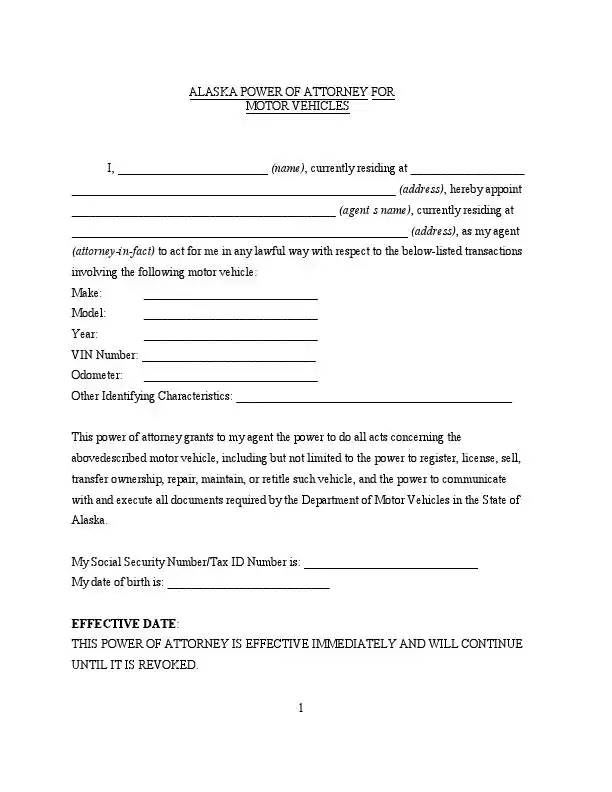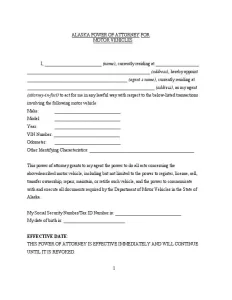Alaska Motor Vehicle Power of Attorney Form
The Alaska motor vehicle power of attorney allows a vehicle owner to authorize another individual, the agent or attorney-in-fact, to handle specific tasks related to their motor vehicle. This includes registering the vehicle, applying for a title, and selling the vehicle on the owner’s behalf. To ensure the power of attorney is valid and enforceable, it must comply with Alaska’s legal requirements.

Build Your Document
Answer a few simple questions to make your document in minutes
Save and Print
Save progress and finish on any device, download and print anytime
Sign and Use
Your valid, lawyer-approved document is ready
According to Alaska Statutes § 13.26.600 – § 13.26.695, the power of attorney form must be completed with precise information about the vehicle owner, the agent, and the vehicle in question. Additionally, the form must specify the powers granted to the agent. The following steps outline the essential signing requirements for the motor vehicle power of attorney form:
- The vehicle owner must sign the form to authorize the agent to act on their behalf.
- A certified notary public must notarize the form. The notary’s signature and seal confirm the vehicle owner’s identity and the authorization’s voluntary nature.
- Although not legally required, it is recommended that the agent sign the form to acknowledge their acceptance of the assigned powers and responsibilities.
Failure to comply with these signing requirements can make the document invalid. Additionally, it is crucial to ensure that the power of attorney form explicitly states the scope of the powers being granted to avoid any ambiguity or misuse.
Refer to the Alaska power of attorney forms for more detailed information on the POA and other related documents.
Alaska Motor Vehicle Power of Attorney Form Details
| Document Name | Alaska Motor Vehicle Power of Attorney Form |
| State Form Name | Alaska Form 847 |
| Relevant Link | Alaska Division of Motor Vehicles |
| Avg. Time to Fill Out | 10 minutes |
| # of Fillable Fields | 13 |
| Available Formats | Adobe PDF |
Filling Out Alaska Vehicle POA
The Alaska Form 847 is a legal document used to grant certain vehicle-related powers from the vehicle owner to another person, known as the attorney-in-fact. This document is crucial for authorizing another party to handle affairs such as vehicle sales, purchases, or registration on behalf of the vehicle owner. The following steps will guide you through filling out the form accurately to ensure its validity.
1. Download the Form
First, obtain the latest version of the motor vehicle power of attorney form from the Alaska Division of Motor Vehicles website. Using the most recent form is essential to avoid any compliance issues. You can also use our template.
2. Enter Vehicle Information
Start by entering detailed information about the vehicle. This section includes the vehicle’s license plate number, serial number (VIN), year, make, model, body style, and color. It’s essential to provide accurate details as this information identifies the specific vehicle associated with the power of attorney.
3. Appoint Your Attorney-in-Fact
Fill in the full legal name of the person you appoint as your attorney-in-fact. This part includes their first, middle, and last names and suffixes. This individual will be authorized to perform the tasks specified in the power of attorney on your behalf.
4. Specify Powers Granted
Indicate the specific powers you are granting to your attorney-in-fact. These powers typically include vehicle purchase, vehicle sale, application for title and registration, and transfer of ownership. Be explicit to avoid any misinterpretation or legal issues in the future.
5. Provide Your Information
As the vehicle owner, enter your full legal name and any company name if applicable. Also, include your license or ID number to validate your identity as the principal granting the power.
6. Sign and Date the Form
You must sign and date the form in the presence of a notary public. The signature section includes your signature and the date you executed the document. Your signature must be an original, not a photocopy.
7. Notarization
The document requires notarization to be legally binding. A notary public will verify your identity, witness your signature, and seal and sign the form. Ensure the notary fills in their name, commission expiration, and, if applicable, their login ID and office location.
